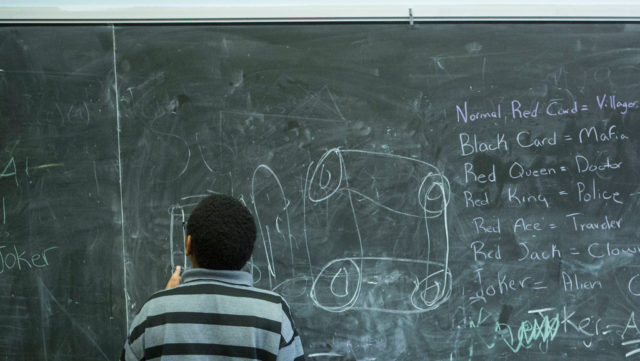Research shows a correlation between greater academic demands and a reduction in drinking, smoking and drug use.

A math camp at Murry Bergtraum High School in New York. Studies have shown that increased high school math graduation requirements have been linked to higher future earnings.CreditAlex Wroblewski/The New York Times
Like all parents of teenagers, I worry that my children will engage in risky behavior, including drinking, smoking and drug use. The more time they spend doing healthier extracurricular activities — soccer, piano, cleaning their rooms (ha!) — the better.
But it turns out that what they do in school can also affect their choices outside the classroom.
Between 1993 and 2013, 40 states and the District of Columbia increased graduation requirements: a specified number of courses in each subject necessary for a high school diploma. The increases have been most common in mathematics and science, and may partly explain the growth in college majors in STEM fields. In 1993, states required between two and six math and science courses for high school graduation. By 2014, the range was four to eight.
A paper in the American Journal of Health Economics suggests a connection: Some of the reduction in risky behavior by teenagers is driven by greater academic demands at school.
Zhuang Hao, an economics Ph.D. candidate, and the economist Benjamin Cowan, both at Washington State University, examined the number of math and science courses that states required for a high school diploma and the relationship to risky behavior among high school students. Their data spanned the years 1993 to 2011 and included over 100,000 students across 47 states (excluding Colorado, Nebraska and Iowa, which did not participate in the surveys of students upon which the analysis relies).
According to the study, these increases in state math and science high school graduation requirements reduced alcohol consumption without any offsetting increase in marijuana or cigarette use. More demanding academic standards decreased the number of days teenagers drank as well as the rate at which they engaged in binge drinking (defined as more than five drinks at a time).
For each additional math or science course required of high school students, the probability they drank or binge drank fell 1.6 percent. The results are a bit larger for males and for nonwhite students.
The study by Mr. Hao and Mr. Cowan could not explain why graduation requirements have larger effects on the behavior of male and nonwhite students. One possible explanation is that male teenagers binge drink more than females, presenting a greater opportunity for reduction.
But that explanation breaks down for nonwhites because they drink less than white students. Here, the explanation could be that nonwhite students are more affected by state requirements because they are more likely to take the minimum number of courses required or attend schools with standards that were lower before the state laws passed. Another study, focused on future earnings, also found that male and nonwhite students benefited more from higher math standards for high school graduation.
One concern is that the results could be explained by high school dropouts. Previous research found that higher requirements encouraged some children to drop out of school and, therefore, out of the study sample. Other work shows that staying in school reduces smoking rates and delays drinking. If those who drop out are the ones more likely to drink, that could skew the findings. However, dropout rates are very low for students under 17 because they are required by law to attend school until that age. The study findings hold up when examining only this younger group.
The study doesn’t explain why greater graduation requirements might reduce risky behavior, but the authors offer two hypotheses. First, greater demands at school take more time: longer hours doing homework and studying. Students who spend more time on schoolwork have less time to do other things. (They could also be reducing sleep or exercise, however.)
Second, a number of other studies have shown that increased high school math graduation requirements have been linked to higher future earnings. This increases the potential loss to students who jeopardize those future earnings through risky behavior. (This second theory requires teenagers to be forward-looking, something parents of teenagers might find implausible.)
Rates of alcohol, drug, and tobacco use among teenagers are high enough to provoke concern among their parents. According to the Centers for Disease Control and Prevention, about one-third of high schoolers consumed alcohol in the last month, and 18 percent had five or more drinks when they did so. One in five had used marijuana in the past month, and more than 5 percent had used cocaine or hallucinogenic drugs. Just over 10 percent of high schoolers smoke cigarettes.
Nevertheless, by some measures, teenagers are engaging in less risky behavior than they used to. Their rates of alcohol and cigarette use have trended downward since the early 1990s, though use of other drugs is up.
Reducing risky behavior early in life is important because habits established in youth often persist into adulthood. Deterring those behaviors early has long-term benefits. A clever body of work takes advantage of school choice lotteries, in which families who win the lottery can place their children in their preferred — typically higher-quality — school. For example, one study of the Charlotte-Mecklenburg, N.C., school district found that lottery-winning middle school and high school enrollees entered higher-quality schools and committed less crime seven years later.
There are other ways the education system can help children be and stay healthy. There are many evidence-based programs that schools can use to directly address the factors that drive or deter substance use. One study found that higher teacher wages are associated with lower mortality. A study of Southern states found that decreasing student-teacher ratios, increasing teachers’ wages, and lengthening the school year are all associated with better future health of students, including reduced smoking, obesity and mortality.
There is variation in results of studies like these. Not all find a connection between education and health or behavioral outcomes. It’s also reasonable to be concerned that when connections are found, correlations are not causation.
But many studies in this area exploit natural experiments: events that are effectively random and not within the control of study participants. “Changes in school quality were generally not the direct choices of families and local communities,” said Ezra Golberstein, an associate professor at the University of Minnesota School of Public Health and a co-author of the study of Southern states. “That increases our confidence that the findings are causal.”
These aren’t the only ways to deter risky behavior by teenagers. Increasing taxes on alcohol and tobacco products also has that effect. But more rigorous demands at school — as well as approaches like lengthening the school year — may deter students from a broader set of risky behavior while better preparing them for higher-wage jobs, things that taxes alone cannot do.
Written by Austin Frakt and published by New York Times ~ April 30, 2018.
 FAIR USE NOTICE: This site contains copyrighted material the use of which has not always been specifically authorized by the copyright owner. We are making such material available in our efforts to advance understanding of environmental, political, human rights, economic, democracy, scientific, and social justice issues, etc. We believe this constitutes a ‘fair use’ of any such copyrighted material as provided for in section 107 of the US Copyright Law. In accordance with Title 17 U. S. C. Section 107, the material on this site is distributed without profit to those who have expressed a prior interest in receiving the included information for research and educational purposes. For more information go to: http://www.law.cornell.edu/uscode/17/107.shtml
FAIR USE NOTICE: This site contains copyrighted material the use of which has not always been specifically authorized by the copyright owner. We are making such material available in our efforts to advance understanding of environmental, political, human rights, economic, democracy, scientific, and social justice issues, etc. We believe this constitutes a ‘fair use’ of any such copyrighted material as provided for in section 107 of the US Copyright Law. In accordance with Title 17 U. S. C. Section 107, the material on this site is distributed without profit to those who have expressed a prior interest in receiving the included information for research and educational purposes. For more information go to: http://www.law.cornell.edu/uscode/17/107.shtml
